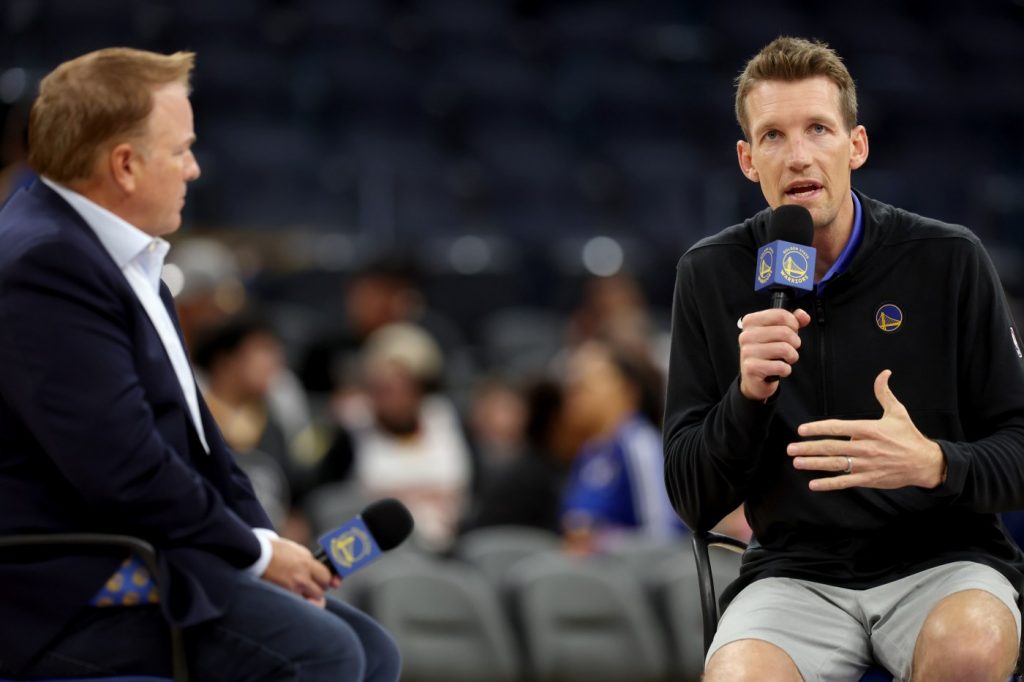The first round of the NBA Draft came and went, with the Warriors staying quiet.
Golden State didn’t trade into the first round and didn’t make any other moves, either. Their only pick, No. 52, comes later today.
For the first time ever, the NBA split the two rounds of the draft into two days.
“I’m intrigued by it,” Warriors general manager Mike Dunleavy Jr. said of the new format earlier this week. “I’m not quite sure how it’s going to unfold. I would imagine it’s going to be a lot less hectic. Normally the draft with the first round and kind of sprinting into the second, you just rip through it. Honestly there’s times where we don’t know whose pick it is, who’s picking, you’ve got two minutes in between.”
Now, teams selecting in the second round will have four minutes on the clock — up from two minutes previously and a minute less than first round selections. Teams league-wide will be calling each other at their draft war rooms, trying to maneuver around as the offseason heats up.
Last year, Dunleavy’s first draft as GM, the Warriors hit a home run with Trayce Jackson-Davis at 57. Not only does Jackson-Davis look like a rotational center for years to come, his contract is a bargain.
Dunleavy and the Warriors will look to repeat that success in this second round, which starts at 1 p.m. on ESPN.
First-round highlights
The Atlanta Hawks won the lottery and selected French forward Zaccharie Risacher with the first overall pick. Alex Sarr, another touted French prospect, went second to the Wizards.
After those two expected picks, the rest of the round unfolded unlike many mock drafts projected.
Ron Holland, a raw G League Ignite prospect, was picked fifth by Detroit. A pair of trades — first between the Blazers and Wizards and then from San Antonio and Minnesota — shook up the lottery. Dalton Knecht, a projected top-10 pick, fell to the Lakers at 17.
Jared McCain, the only projected first-round pick the Warriors brought in for a public workout, was selected 16th by Philadelphia.
Dillon Jones, another Warriors workout participant, got picked by the Thunder at 26.
Beyond them, every one of the prospects the Warriors announced that they brought in for workouts remain available in the second round. So does LeBron James’ son, Bronny.
Warriors targets
The Warriors’ needs may change based on how the offseason unfolds. There are lots of balls in the air, namely Klay Thompson and Chris Paul.
But there are some traits the Warriors should target regardless.
They’re likely to select an experienced college player who has the chance to produce right away. Golden State could use 3-point shooting, size and athleticism at the wing, and an on-ball creator.
At No. 52, it’ll be impossible to add a prospect that checks all three boxes at an NBA level. It’s generally unrealistic to even expect a late second-rounder to contribute at all. But as Jackson-Davis showed, it’s not impossible.
Some names to watch include Jalen Bridges (Baylor), Cam Spencer (UConn), Judah Mintz (Syracuse), Antonio Reeves (Kentucky), Keshad Johnson (Arizona), Pelle Larsson (Arizona), PJ Hall (Clemson) and Quinten Post (Boston College).
Related Articles
Paul George, Chris Paul and the Warriors’ ticking clock
Kurtenbach: Answering your biggest Warriors questions ahead of the NBA Draft, free agency
Kurtenbach: Why I’m not worried about the Warriors losing Klay Thompson (and other Dubs thoughts)
NBA Draft preview: Warriors should target these traits
Mike Dunleavy Jr. ‘hopeful’ Warriors will keep Klay Thompson
Second-round intricacies
Many second-round picks sign two-way deals or contracts with partial guarantees. Teams can use second-round picks to “draft and stash” an international player who isn’t expected to come to the NBA right away.
The rookie scale — allotted salaries based on draft position — only applies to first-round picks.
Under the new collective bargaining agreement, teams are incentivized to sign second-rounders to multi-year guaranteed contracts. Teams are automatically provided a second-round exception, allowing them to sign second-rounders to three- or four-year deals worth at least the minimum — a relief for high-spending teams like Golden State.
“I’m aware once you get into later than second round, that generally ends up being a two-way deal, but there’s also benefits of rostering a second-round pick,” Dunleavy said. “Honestly on that one, it’s pretty wide open.”


